Features
World science day: Bridging the gap between science and society
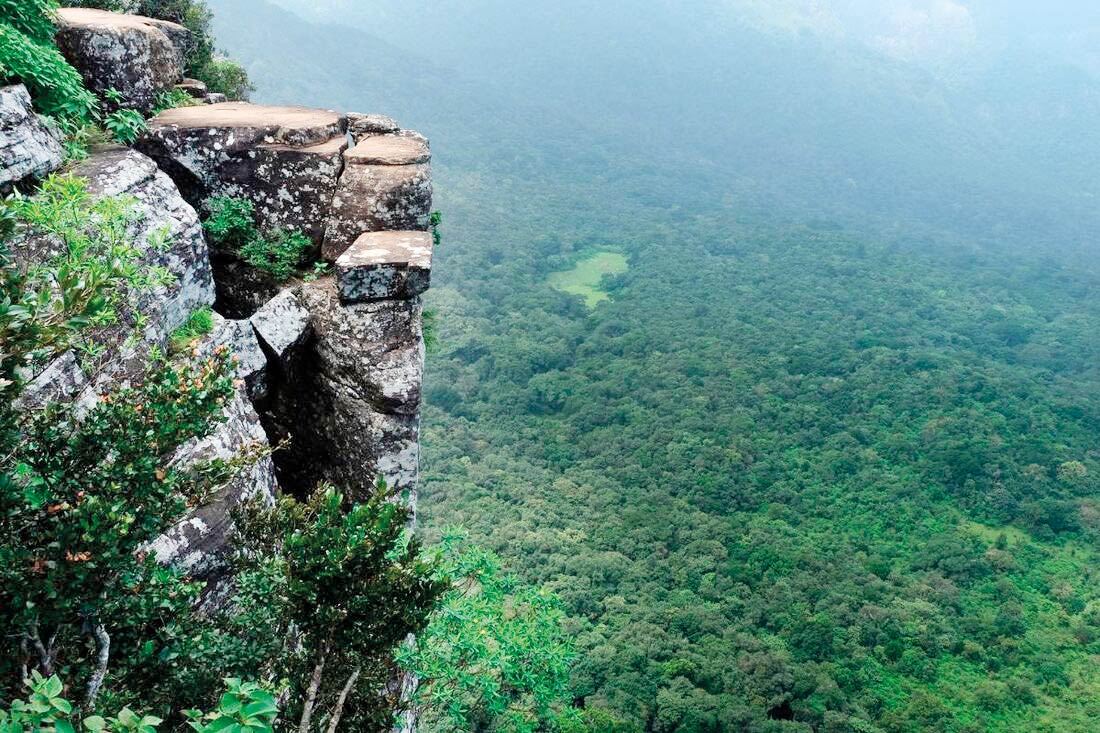
By Prof.Kirthi Tennakone (Email:ktenna@yahoo.co.uk)
Today (Sunday, 10th November) marks the World Science Day for peace and development, intended to highlight the importance of people understanding the value of science and the need for lessening the gap between science and society.
An average Sri Lankan would see science as a means to achieve technological feats and more often an essentiality for his or her children to become doctors or engineers and earn. They consider science a Western artifact, giving them material benefits but secondary to their beliefs, taken as the truths.
Teachers in schools work diligently to meet the above aspirations of citizens and think in the same fashion. Academics in universities are not different from teachers in schools. Except they do research and publish papers to disseminate their findings and a recent trend to boost their rankings.
The above attitude misleads curious students who eventually follow the example of parents, teachers, and professors. After qualifying and gaining employment, they continue with the same traditionalized mindset. Of course there are exceptions among parents, teachers, professors and students but not being a critical mass, they have no collective strength to raise a voice.
Misconceived policy makers dictate that science should be geared exclusively to promote technology and economic advancement. Scientific administrators supported by sectors of the scientific community literally follow the instructions. Often an opportunity for them to undertake less challenging ventures and entertain mediocrity. For that purpose, they would not hesitate to amend statutes and acts.
In the context of the above, I quote below a phrase in a letter written to the journal “Science” by renowned molecular biologist Suraj Bhat about a decade ago.
“It seems that in India, scientists who become successful or achieve some modicum of notoriety eventually become science administrators and preside over decades of myopic science policies and self-preservation, including handpicking those who are “respectful and compliant,” ensuring vertical transmission of mediocrity and incompetence.”
Perhaps India is gaining criticality to naturally diffuse the issue, whereas Sri Lanka seems too far behind. Educational establishments revise curricula to promote the technological aspect of science at the expense of basic prerequisites and the intellectual spirit of science.
New streams of secondary education emerged, branding arts as useless and technology superior, and disconnecting these disciplines from science education. New universities, faculties, departments, and courses more inclined towards technologies dominated education and research in the country. Science faculties took over areas best pursued in engineering schools and technical colleges. Organizations mandated to conduct frontier basic research grossly deviate from those themes, entertaining trivialities where the hierarchies there felt more comfortable.
Reforms were introduced, claiming they would be an avenue to drive innovations. The effort seems to be counterproductive: no innovations but continuation of mediocrity, incuriosity, irrationality, superstition, and apathy.
In order to reduce the gap between science and society, policy makers and citizens need to understand the distinction between science and technology and program education and research accordingly. Technology is a way of doing practically useful things. Technologies existed without science and advanced via trial-and-error exclusion and selection.
Whereas science is a natural thought process based on experience. A method of co-relating things and happenings in nature, seeking explanations and hypotheses. After confirmation by experiments or observation, hypotheses evolve into theories, logical structures possessing predictive power. Therefore, the theories enable planning and arrive at innovations without extensive time-consuming trial-and-error experimentation.
Science and its theories not only stand as the foundation for modern technology but also the essence that triggers innovations, providing solutions to problems. Technology progresses incrementally and by quantum jumps via scientific discoveries. Furthermore, science and technology move forward hand in hand. Science leads to new technologies, which in turn facilitate new discoveries. Semiconductors developed as a result of curiosity-oriented research transformed electrical technology delivering thousands of appliances used in households, communication, transportation, medicine, etc. Their use in research facilitated so many new discoveries and technologies (AI for example).
To build an economy through technology, a nation needs to create an atmosphere conducive to scientific discoveries. Bridge the gap between science and society by building confidence and delineating the distinctions from beliefs. The latter safeguards ethics but does not lead way to discoveries or understanding of the workings of nature.
If parents expose their children to dogma and superstition, conditioning them to believe things that are irrational or never realized. And if science, the antithetical is introduced by teachers, who have the same mindset as parents. Can we expect the posterity to be discoverers and innovators?
General public should also be aware that science does not subscribe to an individual’s opinion, without critical analysis, irrespective of his or her authority.
A quote often attributed to represent the character of Richard Feynman, one of the foremost quantum theorists is: “Pursuit of science requires some irreverence (lack of respect or disrespect for any authority or authoritative opinion). Irreverence doesn’t mean not paying respect to those who deserve it. One should respect elderly, teachers and religious dignitaries but not accept their opinions without rational inquiry.”
A pinnacle of Gautama Buddha’s teaching is the Kalama Sutra, which we don’t follow. Late Prof. K.N. Jayatilleke, commenting on the subject in his book “Early Buddhist Theory of Knowledge, states: “Buddha seems to demand from his hearers regarding his own statements. He does not want his own statements accepted on his authority nor rejected but seems to demand that they be tested and accepted if they are found to be true and presumably rejected if they are found to be false.”
A lesser-known related script referred to in Hindu and Buddhist literature, “Nayana Sutra” says: To arrive at the truth, one should follow the guideline: Anumana (possible inference suggested from existing knowledge), Pratyaksha (confirmation), Upama (illustrative examples) and Aptavakya (concluding authoritative statement).
Today, researchers divide their reports into sections: Introduction, Experiments, Results and Discussions and Conclusion. However, major breakthroughs in science have been an ‘anumana’ to begin with.
In 1935, German bacteriologist Gerhard Domagk prescribed a dye found to be antibacterial, in laboratory experiments to his only daughter, fatally ill after contracting a streptococcal infection and cured her – the discovery of the first antibacterial chemotherapeutic agent, sulfonamide. Science requires undertaking risks and challenges. We need to tell these stories to our students, instead of promoting authors on the basis of the multitude of papers they publish every year. Scientists disseminate their findings for critical assessment by peers. They are also obligated to educate the public and contribute to national development, instead some advertise their ranking and percentages purported as a measure of the scientific standard.
An investigation carried out to solve a major problem normally requires years of dedicated work, but the paper output could be just one article.
Crick and Watson’s discovery of DNA replication, published as a one-page article in the journal Nature in1953 was a clever anumana, confirmed four years later by experiment. Finding transformed biology, heavily impacting technology.
Science justifies its findings by repeated observation and analysis using logic and mathematics. Does not assume things as true or false on the basis of faith. Its own findings and assertions are continuously subjected to strict scrutiny to detect faults and errors. Unlike beliefs, when a fault is detected and confirmed, no attempts will be made to cover it up. Instead, it arouses curiosity, demanding further theoretical analysis and experiment. Sometimes, experimentation is costly, but unavoidable. The large hadron collider at CERN Geneva was built primarily to detect the Higgs boson because the validity of the most up- to-date theory of matter rested on its existence. If the boson was not found, curious minds will think differently, and that’s how science advances.
A nation should also undertake projects to unravel the deepest secrets of nature. Such endeavors build the morale of a nation, diverting the attention of the citizens to science and encouraging the young. All the countries in the East that attained comparable technological advancement after the rise of the West had commissioned such projects.
It is heartening that Sri Lanka had the political will to support advanced frontier basic research beginning post-independence. Unfortunately, obstacles to these efforts arose from the myopic attitude of the science administrator and not from the political establishment.
Few Sri Lankans who went to the United Kingdom about a decade before independence worked with the world’s topmost scientists at the time. A. W. Mailvagnam (the first Professor of Physics, University of Ceylon) did research in Cambridge at the time of Sir J.J. Thompson (discoverer of the electron) and Lord Ernest Rutherford (discoverer of the atomic structure). C.J. Eliezer (Professor of Mathematics, University of Ceylon) was a student of Paul Dirac, who revolutionized. physics by showing that the electron should be accompanied by another particle (positron), identical to it but having opposite charge.
Both of them, supported by another Sri Lankan intellectual, Senarath Paranavithana, proposed the establishment of the Institute of Fundamental Studies in the early 1950s. The purpose was to conduct theoretical studies. Theoretical studies cost very little but profoundly impact the science of a nation. Today, most countries in Asia, and a few in Africa, have institutions dedicated to theoretical studies. The idea advocated by A.W. Mailvagnam, C.J. Eliezer, and Senarath Paranavithana stands more important today than during their time.
Almost all recent achievements in science and technology originated as a result of subsequent advanced studies. Unfortunately, fundamental research is disappearing from Sri Lanka’s science agenda. I hope the new government will look into this crucial issue essential for fostering science
We are familiar with mega developmental engineering projects such as hydroelectric power and river diversions, commissioned at a cost of millions of dollars, expecting hundreds of times returns in decades. Today, countries launch mega-projects of that magnitude to find answers to the most perplexing questions in fundamental science without expecting any monetary gains. Are these justified? Yes, because here the intellectual return is more valuable than money. And that profit eventually turns into a monetary gain with high interest by motivating the human resource to innovate.
This year China is to expected complete the construction of the dollars 300 million Jiangmen Underground Neutrino Observatory. Its primary purpose is to assess the weights of the tiniest entities in the universe known as neutrinos. They occur in three different forms, with weights in the range of decillions (1 divided by 33 zeros after 1) grams. The aim of the 300-million-dollar experiment would be to determine which one of these is the heaviest! Answering this question has far reaching implications, including why matter exists.
Today, even less developed nations have recognized the importance of active involvement in mega-science projects. South Africa, in collaboration with Australia, plans to construct the Square Kilometer Radio Array to probe furthest into space. The High Energy Stereoscopic System to detect and locate sources of gamma radiation, an international facility, is housed in Namibia because of the excellent atmospheric opacity near the Gamberg mountains. In 2018,the Indian government granted approval for construction of a neutrino observatory at Bodhi Hills, Tamil Nadu.
Can Sri Lanka afford mega – science projects? Obviously, Sri Lanka at the moment cannot commit millions of dollars for projects of that nature. However, our unique geography may be exploited to attract international collaborations with our active participation, as Namibia did.
In 1972, I attended a conference in Sicily as a student who had just completed a Ph.D. in theoretical physics, returning from the United States to Sri Lanka via Europe. At the conference, I suggested that the World’s End base in Sri Lanka, near Balangoda, could be an ideal site for the construction of an underground laboratory for the detection of neutrinos. At that time, facilities of the type now constructed in China did not exist. A European group seriously considered the new concept I proposed and encouraged me to submit a proposal immediately after my return to Sri Lanka. However, because of circumstances too lengthy to elaborate here, I could not do it.
Lately, in 2016, Dhammika Tantrigoda (former Professor of Physics, University of Jayewardenepura) conveyed the above story to the Minister of Science and Technology in a discussion on basic science policy in his capacity as the Chairman of the National Science and Technology Commission. The Minister invited me to give a presentation. At a meeting where he and a number of leading scientists were present, I said, unlike in 1972, there are underground laboratories functioning, and the competition is high; as several are in the pipeline, obtaining external funding would be hard. Yet a feasibility study is worth it.
Particle detector technology will change in the future. The decision was to form a study group as a project of the Ministry of Science Technology to pursue Astroparticle Physics in Sri Lanka. As usual, the idea didn’t move forward. It was not the fault of the minister or the scientists who participated; they were very supportive and endorsed my opinion that Sri Lanka should think big and enter the international arena of advanced research.
The public should also be made aware of the necessity of our participation in attempts to understand the most tantalizing puzzles of nature
Although the method of science applies profitably to human affairs, science is not everything. Ethics as taught in religions, art, literature, and discourse on beliefs are equally important. Both Eastern and Western philosophies benefit society. The scientific method is hidden in the former, and the latter focuses on abstract thinking in addition. To induce abstract thinking, we need to promote mathematics and theoretical studies.
Science originated in the West as a result of the abstract thinking and questioning of beliefs by Greeks. Knowledge other than science is symbiotic to science and stands against abuse of science in war, inflecting cruelty to animals, and endangering of the environment.
The failure to distinguish science from beliefs and science from technology is largely the cause of our weakness in both science and technology.
(The author was a former director and professor at the Institute of Fundamental Studies and the first Professor of Physics, University of Ruhuna. Educated in Sri Lanka and the United States he has conducted research in several institutions in United States, Europe and Japan. He began his academic career as a physics and mathematics teacher at the Veyangoda Madya Maha Vidyalaya.)
Features
Ghana wants more for its cashews, but it’s a tough nut to crack
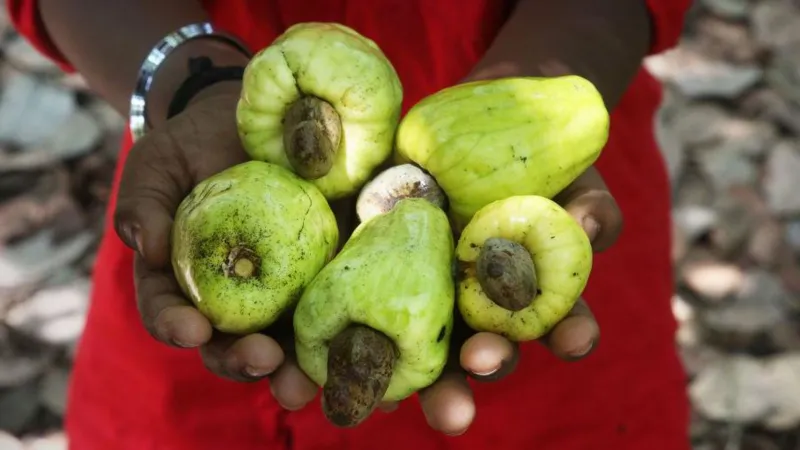
The Accra street vendor looks at me, bemused.
I’m trying to establish how the rather flimsy 30g bag of roasted cashew nuts she’s selling, beside a sweltering highway in Ghana’s capital, costs me the equivalent of about 75 cents (60p).
That’s obviously not a lot of money for me, a visitor from the UK, but I’m amazed at the mark up. The price is at least 4,000% higher than the cost of buying the same weight of raw, unshelled cashews from a Ghanian farmer. “It’s incredible,” I protest. Yet she doesn’t understand my English, or my reasoning.
The price of the nuts was, after all, printed on the packet. And explaining why I thought it was beyond the pale was never going to be easy.
Ghana is the world’s third biggest exporter of unprocessed cashew nuts, behind Ivory Coast in first place, and Cambodia in second.
To produce the crop, around 300,000 Ghanaians make at least part of their living growing cashews.
Nashiru Seydou, whose family have a farm in the country’s north-east, some 500 miles (800km) from Accra, is one of them. He says the work is hard, and unreliable supply chains and volatile wholesale prices make survival difficult. “We are struggling. We can use the sunlight, the fertile land, to create more jobs,” he says. “I’d be happy if the government comes to our aid and helps support our industry.”
He tells me that he currently gets around $50 for a large 100kg sack of unshelled cashews.
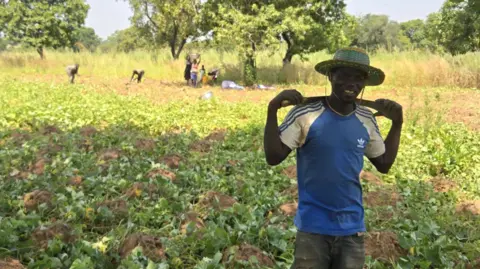
“It’s amazing,” says Bright Simons, an entrepreneur and economic commentator in Accra, who has studied the numbers. “Roasters and retailers buy the nuts from farmers for $500 a tonne, and sell to customers [both at home and abroad] for amounts between $20,000 and $40,000 a tonne.”
As a whole, Ghana grows about 180,000 tonnes of cashews annually. More than 80% is exported, and in raw, unshelled form. This generates some $300m in export revenues, but means that Ghana misses out on the significantly higher returns you get from roasted, ready-to-eat cashews.
Mildred Akotia is one person trying to increase the amount of cashews that are shelled and roasted in Ghana. She is the founder and CEO of Akwaaba Fine Foods, which currently processes just 25 tonnes a year. Ms Akotia denies any suggestion that she and others like her are price-gouging. The packaging and roasting machinery a western business would automatically use in this industry, she says, is out of reach for her because of the high cost of credit in Ghana.
“If you go to a local bank, it will cost you 30% interest to get a loan,” she complains. “As a manufacturer you tell me how large your margins are that you can afford that kind of interest? We’ve had to rely on what we can get: soft loans from relatives and grants from donor agencies.”
She says that this situation is why less than 20% of Ghana’s cashews are processed locally. The bulk are scooped up and exported to big factories in countries like India, Thailand and Vietnam.
Remarkably, some of those packaged nuts are then exported back to Ghana, where they are sold for the same price as domestically roasted cashews. This is despite the 20,000-mile sea freight round trip, and import costs.
It is a similar picture for rice, which is exported to Ghana from Asia and sold at low prices, despite Ghana also growing the crop itself.

Back in 2016 the Ghanaian government experimented with an export ban on raw cashews in order to encourage homegrown processing. However the policy had to be abandoned within a couple of weeks after uproar from farmers and traders.
Without available cheap loans, it wasn’t possible for sufficient new Ghanaian roasters to enter the market. So the price of raw nuts crashed, and many started rotting for want of a buyer.
More recently there has been talk of increased tariffs on raw cashew exports and bans on exporters purchasing cashews directly from farms.
But all these policy interventions miss a key point, according to Mr Simons. A big challenge for local producers, he says, is to work harder on the basics of doing business, and growing their companies.
“In order to be efficient at this, you need scale,” he says, adding that firms need to promote eating cashews to make it more widespread in the country. “You need a lot of a Ghanaians consuming the nuts, not just a small middle class”.
Prof Daron Acemoglu, a Turkish-American economist, agrees that building a strong local market is important for Ghana’s cashew industry. He was one of last year’s winners of the Nobel Memorial Prize in Economic Sciences, for his work on the struggles facing low-income economies, and in particular their home-grown businesses.
Yet he says that the first priority should be improving access to international markets for processed Ghanaian cashews.
“These firms are dealing with workforces that aren’t properly skilled, they have infrastructures that aren’t working, they are constantly in fear of corrupt officials, or rule changes, and also it’s very difficult to reach foreign markets, he says. “They need the foreign market because the domestic market is small, and their own government has very little capacity [to boost it].”
He also wants to see the Ghanaian government improve the network of roads and railways to ease the cost of transportation.
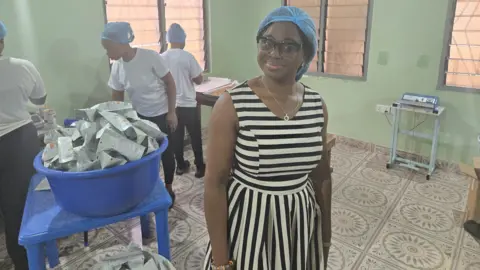
But Mr Simons reckons the onus should now be on Ghanaian businesses themselves, to do the basics to enhance the branding and marketing of cashews. As it is, he says, many of the country’s most enterprising business people are just leaving Ghana for better paid opportunities abroad because of the red tape and cronyism in Ghana are so prohibitive.
“There’s a massive brain drain,” he says. “My theory of why Africa’s economic development has been slow is because we focus too much on the supply side, but the real beauty is in demand, creating a consuming class of cashew-eating enthusiasts, and you don’t have an entrepreneurial class that can create demand transformation.”
He says the same argument applies to Ghana’s other bigger exports, like gold and chocolate, neither of which gets much value-addition within Ghana before getting exported to the West.
Mildred Akotia hopes she might be one of those entrepreneurs to buck the trend. She now wants to build her own logistics arm, to be able to process the cashews direct from the farm gate.
“I have a lot of calls from the UAE, from Canada and America. Currently we can’t meet demand. We can’t get enough kernels to roast. “There’s a ready market both locally and internationally. My branding is good, my marketing is good. My dream is to give a facelift to Ghanaian processed foods.”
[BBC]
Features
Trump’s ultra-nationalistic policies:
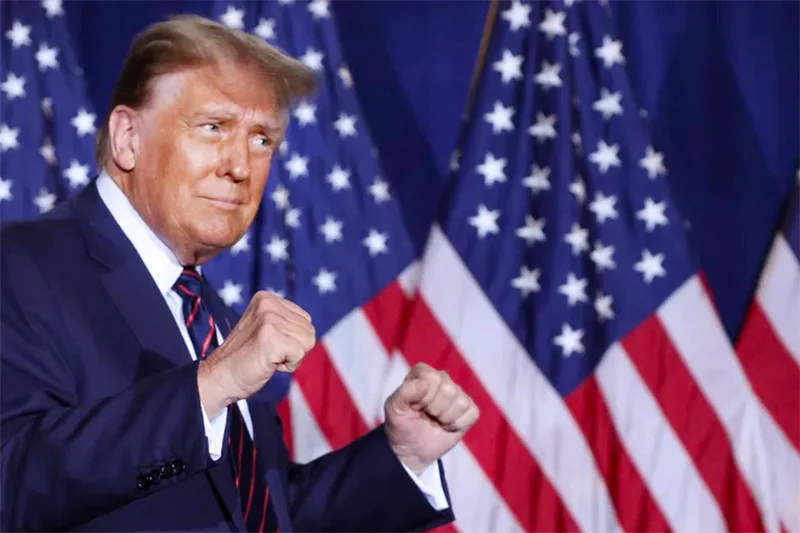
An era of ‘America First’
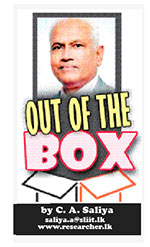 In his inaugural address, US President Donald Trump recently declared that “the golden age of America” was starting as he listed his priorities on trade, immigration, and national security. His previous presidency, which ended in 2021, left a profound mark on American domestic policies and global relations, especially through his ultra-nationalistic ‘America First’ doctrine. As he pursues re-election in 2024, the effects of his policies continue to influence both American politics and the global order, sparking ongoing debates about economic nationalism, immigration, trade, and America’s international role.
In his inaugural address, US President Donald Trump recently declared that “the golden age of America” was starting as he listed his priorities on trade, immigration, and national security. His previous presidency, which ended in 2021, left a profound mark on American domestic policies and global relations, especially through his ultra-nationalistic ‘America First’ doctrine. As he pursues re-election in 2024, the effects of his policies continue to influence both American politics and the global order, sparking ongoing debates about economic nationalism, immigration, trade, and America’s international role.
Economic Nationalism:
Protectionism and Trade Wars
A core component of Trump’s ultra-nationalistic agenda was his approach to trade, which aimed to reduce US dependence on foreign imports and rebalance trade relations. Trump’s withdrawal from the Trans-Pacific Partnership (TPP) and the renegotiation of NAFTA into the United States-Mexico-Canada Agreement (USMCA) reflected this goal. The new trade deal included provisions that favoured American workers and industries.
Trump’s trade war with China, marked by the imposition of tariffs on steel, aluminum, and Chinese goods, aimed to protect American manufacturing and address trade imbalances. However, these tariffs disrupted global supply chains and strained relationships with key allies. Critics argued that the trade measures hurt American consumers and businesses reliant on imports, while supporters saw them as necessary steps to confront unfair trade practices.
Immigration Policies: Restrictionism
and Border Security
Trump’s ultra-nationalism was also evident in his strict immigration policies, which he justified as essential for national security and cultural preservation. His administration’s “zero tolerance” policy, which resulted in family separations at the southern border, sparked widespread outrage. The US-Mexico border wall became a symbol of his presidency, with Trump arguing that it would reduce illegal immigration and drug trafficking. However, its effectiveness remained a contentious issue.
Additionally, the travel ban restricting immigration from predominantly Muslim countries was seen by opponents as discriminatory and in conflict with American ideals of diversity and inclusion.
Foreign Policy: America
as a Lone Actor
Trump’s foreign policy emphasized America’s sovereignty over international cooperation, often adopting a more isolationist stance. He frequently criticized multinational organizations, such as NATO and the United Nations, accusing them of unfairly benefiting from American contributions. Trump withdrew the US from the Paris Climate Agreement, arguing that it disadvantaged American industries, and he also pulled out of the Iran nuclear deal, opting for a more unilateral approach.
His administration’s focus on bilateral agreements over multilateral diplomacy continued his ‘America First’ stance, which sought to prioritize American interests over global cooperation.
Cultural Nationalism and
Populist Rhetoric
Trump’s rhetoric tapped into a cultural nationalism, emphasizing traditional American values and critiquing globalism. His message resonated with working-class Americans who felt left behind by globalization and demographic changes. However, his inflammatory language often exacerbated divisions within the US, particularly with minority groups.
Trump’s Legacy: Polarizing
but Persistent
Trump’s ultra-nationalistic policies were praised by supporters for their bold assertion of American sovereignty and self-reliance. Critics, however, argue that these policies eroded global cooperation and undermined America’s global leadership. Domestically, they were seen as deepening political polarization and neglecting the country’s multicultural identity.
While Trump’s previous presidency officially ended in 2021, his influence persists, especially as he seeks to reclaim the White House in 2024. The ripple effects of his policies continue to reverberate across American politics and global relations, embodying both the promises and perils of his ‘America First’ agenda.
Economic Impact
Trump’s protectionist economic policies had a complex impact. While his tariffs on imports and tax cuts aimed to boost domestic production, they also disrupted global trade and raised costs for US businesses and consumers. His tax reforms, designed to stimulate growth, contributed to higher national debt without yielding substantial wage growth or long-term investment benefits. Trump’s stance also led to a decline in foreign direct investment (FDI) as global investors faced increased uncertainty.
Impact on Trade Partners
Trump’s trade policies reshaped relationships with countries like China, Mexico, Canada, and the European Union. The trade war with China, for instance, led to reduced exports and higher consumer costs. The renegotiated USMCA imposed stricter labour and environmental standards on Canada and Mexico, altering the competitiveness of industries in both countries. Meanwhile, tariffs imposed on European products disrupted the automotive and steel industries.
Impact on Developing Countries
For developing nations, which rely heavily on trade with the US, Trump’s policies increased trade barriers and disrupted global supply chains. Countries in Asia, Africa, and Latin America faced challenges in maintaining access to the US market, which limited their economic growth potential. His withdrawal from multilateral agreements, like the TPP, further restricted trade opportunities for developing countries.
Direct Impacts on Sri Lanka
Sri Lanka, heavily dependent on exports to the US, saw the effects of Trump’s protectionist measures. Despite benefiting from tariff-free access, under the US Generalized System of Preferences (GSP), Sri Lankan exporters faced heightened uncertainty due to the renegotiation of trade agreements and the imposition of tariffs. Trump’s ‘America First’ strategy reduced demand for imports from developing countries like Sri Lanka, making it harder for industries such as textiles and apparel to thrive.
Additionally, Trump’s tax reforms, which incentivized US companies to repatriate profits, led to reduced foreign investment in Sri Lanka, particularly in sectors like tourism, manufacturing, and technology.
Indirect Impacts on Sri Lanka
The US-China trade war had a significant indirect impact on Sri Lanka’s economy, as China’s reduced access to the US market led to a decline in demand for Sri Lankan exports to Chinese industries. At the same time, the trade war disrupted global supply chains, affecting Sri Lanka’s participation in regional production networks. However, there were some positive effects, particularly in the apparel sector, where Sri Lanka briefly gained market share as American buyers sought alternatives to Chinese products.
Debt Sustainability and Dollar
Appreciation
Trump’s tax cuts and tariff measures contributed to the appreciation of the US dollar, which had adverse effects on Sri Lanka. The stronger dollar increased Sri Lanka’s dollar-denominated debt servicing costs, exacerbating fiscal deficits and limiting its ability to finance essential development projects. It also pushed up the cost of imports, leading to inflationary pressures on goods like fuel and food.
Geopolitical Implications
Trump’s reduced focus on South Asia and disengagement from multilateral organizations opened the door for China to expand its influence in the region, particularly through initiatives like the Belt and Road Initiative (BRI). Sri Lanka deepened economic ties with China, including major infrastructure projects, like the Colombo Port City and Hambantota Port, which increased Sri Lanka’s dependence on Chinese financing. Critics argue that this dependency undermines Sri Lanka’s policy autonomy.
Impact on Remittances
Sri Lanka’s reliance on remittances from overseas workers was also indirectly affected by Trump’s immigration policies. Stricter immigration restrictions and a reduced openness to foreign workers in countries like the US and the Gulf States led to fewer employment opportunities for Sri Lankan migrant workers, thereby impacting remittance inflows that are crucial to Sri Lanka’s economy.
In conclusion, Donald Trump’s ultra-nationalistic policies, which reshaped both American and global landscapes during his presidency, continue to reverberate in the 2024 election cycle. His ‘America First’ approach, while securing the support of a significant portion of the American electorate, has also sparked intense global debate over the trade-offs between national sovereignty and international cooperation. For nations like Sri Lanka, Trump’s protectionist trade measures, shifting geopolitical priorities, and tax reforms have had profound effects on exports, foreign investment, and economic stability. As Trump seeks a return to the White House, the legacy of his policies will remain a defining feature of American politics, global trade, and international relations, forcing nations to navigate the complexities of a world where economic nationalism increasingly dictates the rules of engagement.
(The writer, a senior Chartered Accountant and professional banker, is Professor at SLIIT University, Malabe. He is also the author of the “Doing Social Research and Publishing Results”, a Springer publication (Singapore), and “Samaja Gaveshakaya (in Sinhala). Views expressed in this article are personal. He can be contacted at saliya.a@slit.lk and www.researcher.com)
Features
The President’s Jaffna visit and its implications
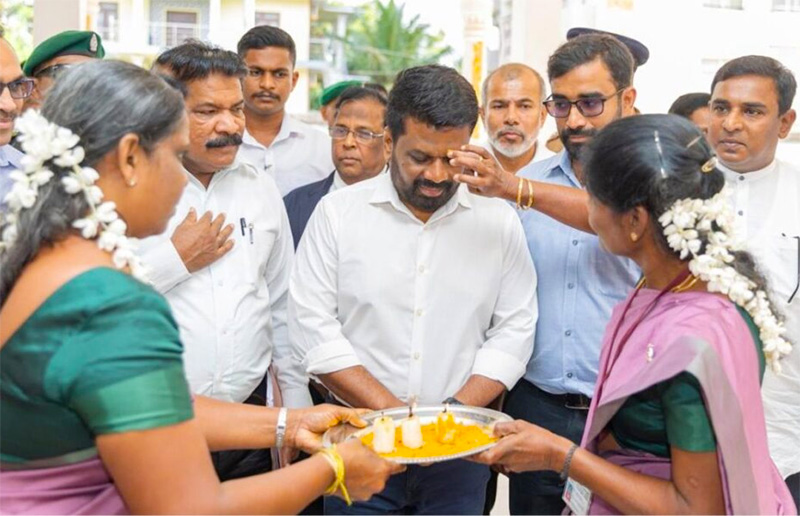
by Jehan Perera
President Anura Kumara Dissanayake is showing the change for the better that a single individual can bring by challenging old ways of doing things by those who have traditionally governed the country. According to the news media and first person accounts by reliable commentators contacted in Jaffna, the president’s visit to the Jaffna peninsula last week was a resounding success that is good for the unity of the country. It seems that the president timed his visit to the north in the context of forthcoming local government elections that are anticipated to be held in April.
The focus on Jaffna during his visit would have been the central place that Jaffna has as the civilisational seat of the Tamil people. The president used the time he had allocated to Jaffna to pay his last respects to former parliamentarian and leader of ITAK (Federal Party) who had, for decades, been at the forefront of the Tamil struggle for regional self-government, devolution of power and equal rights. He also had the confidence to go to Valvettithurai which was the birthplace of the late LTTE leader Velupillai Prabakaran and conduct a public meeting there.
The president’s visit took place without the usual high security in which large numbers of soldiers would be placed at strategic locations not only in the areas that the president would be visiting but also on the approach roads to Jaffna. Residents observed that the security presence appeared to be low in comparison to the past, when roads would be closed and security personnel stationed on a 24-hour basis on the roads in residential areas. The reduced level of security demonstrated the president’s trust in the goodwill of the people. During his visit he mingled at close quarters with the people, being embraced and having his photographs taken with them.
EVERYDAY FOCUS
Addressing the people, President Dissanayake promised to bring development to Jaffna. In the year prior to the onset of fierce fighting in Jaffna that destroyed its housing and factories, Jaffna had a handful of industries, chief amongst them being the salterns in Paranthan and the cement factory at Kankesanthurai. The president pledged to rebuild these industries and to establish three new industrial zones in Paranthan, Mankulam, and Kankesanthurai to boost employment and economic growth. Sri Lankans who emigrated due to the war were invited to invest in these projects.
The president also used the occasion of his visit to present an analysis of the reasons for the ethnic conflict the country had experienced. He said that previous generations of politicians had used ethnic nationalism as a means to win elections and this had resulted in the division of people into different communities that did not trust each other. However, the last general election that had brought the NPP to power had seen the people reject the traditional political leaders who came from elite families. Instead, they had voted for the NPP regardless of ethnicity, religion or region. The president pointed out that this was a new development.
The general election in December last year saw the NPP win the majority of parliamentary seats in the north and east which have traditionally voted for Tamil political parties which take up an ethnic Tamil nationalist line. The main issues they have canvassed have been Tamil equality and self-rule in the north and east. However, those parties have never been able to deliver on the mandates they received at elections. Some of the Tamil parties reached agreements with the ruling parties of those days, but were invariably let down. The president’s focus on the everyday problems of the people would be important in inducing them to vote for the NPP at the forthcoming local government elections.
UNHRC RESOLUTION
It is worth noting that President Dissanayake made a positive impact on the people of Jaffna even though he did not address the issues of Tamil nationalism and self-rule that have preoccupied them in the past. The fact that the forthcoming elections are local level ones also reduces the significance of national issues. Local government elections the world over are about local level issues rather than national ones. In his public speeches the president spoke about providing jobs to unemployed university graduates from the 30,000 vacancies in state institutions. He stated that Tamil speaking police officers would be recruited. He also referred to improving the water supply schemes to the people of the north, making the observation that they had the lowest consumption of piped drinking water in the country
The president would be aware that whatever concession he makes to Tamil nationalism will be seized upon by his political opponents in the south of the country to fan Sinhalese nationalism. There are indications that the former ruling parties that got defeated at the last presidential and general elections are seeking to make a comeback by coalescing with one another. Their concern about the present political developments would have been increased by the president’s statements in Jaffna that the government would not permit the self-seeking traditional political elites to divide the people anymore and that they will be held accountable before the law for corruption they have engaged in.
The president’s analysis in Jaffna that ethnic nationalism was used by rival political parties to obtain electoral support to prevail at elections is an accurate one. However, the underlying issues that the ethnic nationalist politicians utilised to come to power need to be dealt with in a way that is mutually accepted by all communities. Sri Lanka is still in a post-war situation where there is no more war. But the causes and consequences of the war still remain unresolved in the form of missing persons, long term prisoners, land that is under military occupation and the continuing high military presence in the north and east of the country.
Sri Lanka now needs to become a post-conflict society. This requires that the issues of the war that continue to unresolved be dealt with without further delay. This is what the UNHRC resolutions in Geneva that come up time and time again are about. There have been 16 IMF agreements in the past but not a single government could implement them to the end. It appears that the present government is determined to go the course to get Sri Lanka onto a sound economic footing. In the case of the ethnic conflict there have been many political solutions proposed to politically resolve the ethnic conflict. But no government has had the strength or conviction to take them forward and ensure sustainable national unity. Perhaps government led by President Dissanayake will.
-
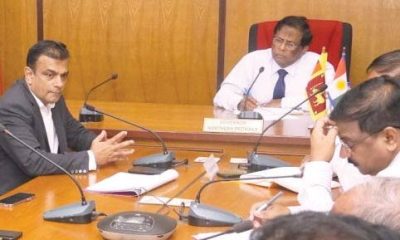
 News4 days ago
News4 days agoNew Bangalore-Jaffna flights in the works
-
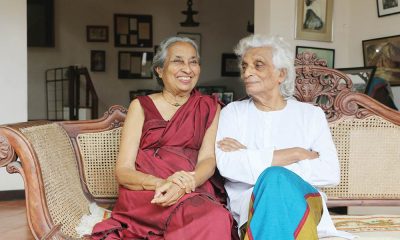
 Features6 days ago
Features6 days agoA singular modern Lankan mentor – Part I
-
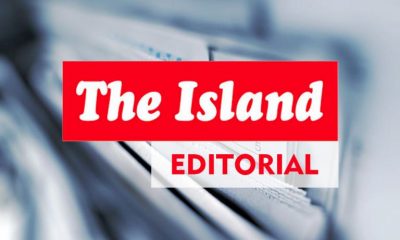
 Editorial7 days ago
Editorial7 days agoRegime changes and scandals
-
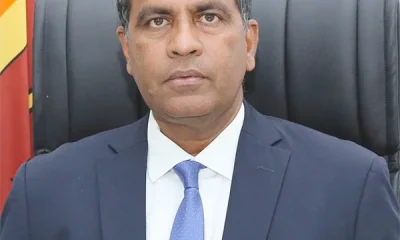
 News7 days ago
News7 days agoCustoms cleared thousands of ‘marked’ containers sans examination beginning last year
-
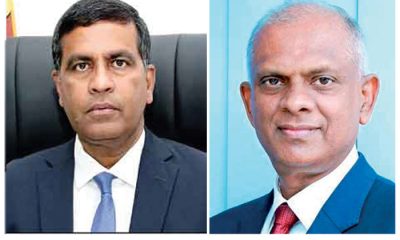
 News2 days ago
News2 days agoCID questions top official over releasing of 323 containers
-
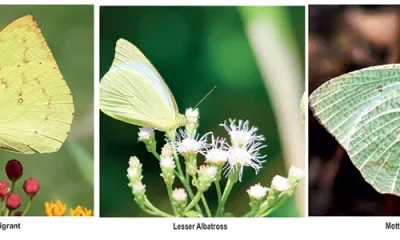
 Features7 days ago
Features7 days agoButterfly migration fading away
-
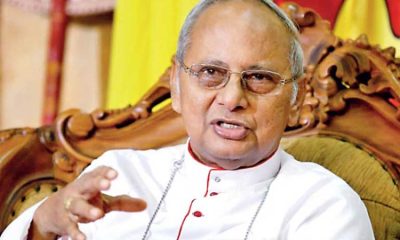
 News4 days ago
News4 days agoCardinal says ‘dark forces’ behind Easter bombs will soon be exposed
-
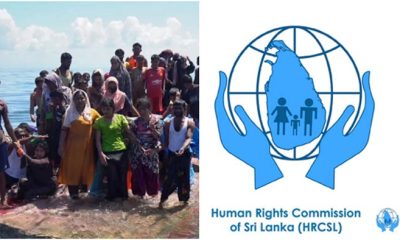
 News4 days ago
News4 days agoHRCL reports on Rohingya asylum seekers

